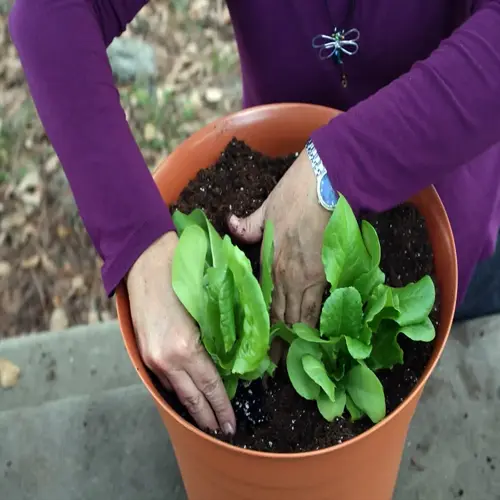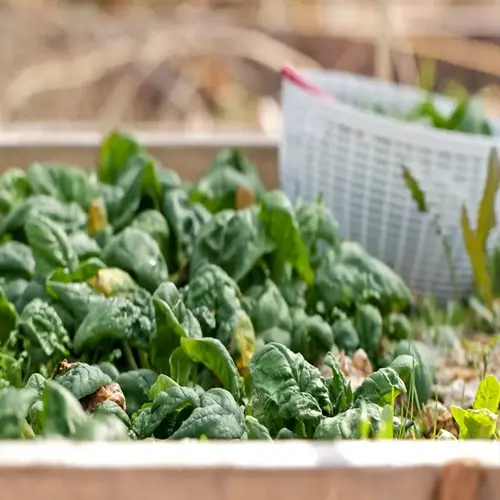When to Plant Radishes: Expert Tips

Written by
Kiana Okafor
Reviewed by
Prof. Samuel Fitzgerald, Ph.D.Suggested to plant radishes 2-4 weeks prior to last spring's frost for best growth.
For fall harvests, plant seeds 6-8 weeks prior to the first frost date.
In mild climates (zones 9-11), plant winter radishes starting in October through January.
Do not plant in the summer when the temperature is consistently above 70°F because radishes may bolt.
Plant every 2-4 weeks (succession planting) for continued harvest of radishes.
Make sure to check the USDA zone guide for your area to be precise about when to plant your radishes.
Article Navigation
Determining the best times to sow radishes will help you grow crisp roots in time because they are quick-growing vegetables. Radishes are great for beginners because they are ready to harvest in just four to six weeks. They originated in Southeast Asia and came to Europe in the 16th century. Gardeners loved them for hundreds of years.
There are many ways to enjoy radishes. You can enjoy them raw, adding a pleasing crunch to salads. Pickled, they make a tangy snack. Cooked in stir-fries or soups. This guide covers more than just the time of planting. You will also find information on soil preparation, care tips, and harvesting techniques to help you optimize your growing season.
Why Grow Radishes
Radishes produce quick results compared to other vegetables. It generally takes months for other root vegetables, such as carrots, or fruiting vegetables, like tomatoes, to reach the harvest stage. Radishes go from seed to harvest in just three to six weeks. Their rapid growth means you can still get multiple harvests in a growing season that is both fast and rewarding! Keeping excitement in gardening is hard!
Radishes can be grown in small areas, such as balconies or windowsills. They fit nicely in little containers or small spaces in the garden. This makes them ideal for urban gardeners who have limited space. Kids love to see them grow so quickly.
When it comes to nutritious veggies, the humble radish is really underrated. One serving contains a generous amount of Vitamin C to help boost your immune system, potassium for heart health, and fiber for healthy digestion. All in one simple-to-grow crop.
Cultivating radishes can teach kids about plant life cycles in a very cool way. Children have the opportunity to see seeds sprout in a matter of weeks, rather than months, which quickly sparks their curiosity about nature and healthy food. It creates long-lasting memories of gardening.
Rapid Harvest
- Radishes mature incredibly quickly, typically ready for harvest in just three to six weeks, which is significantly faster than most garden vegetables like tomatoes or carrots that take months to develop.
Space Efficient
- These compact plants thrive in small gardens, containers, or between rows of slower-growing crops, making them perfect for balconies, patios, or urban gardens where space is limited and valuable.
Beginner Friendly
- With minimal requirements for soil quality and care, radishes are exceptionally forgiving for first-time gardeners, helping build confidence before moving to more challenging plants that need precise conditions.
Nutritional Value
- Both the crisp roots and leafy greens are rich sources of vitamin C for immunity, potassium for heart health, and digestive-friendly fiber, offering superior flavor and nutrients when homegrown.
Educational Tool
- The complete visible growth cycle from seed to harvest in just weeks makes radishes ideal for teaching children about plant biology, responsibility through daily care, and the food production process.
Low Maintenance
- Radishes require minimal intervention beyond basic watering and thinning, with no complex pruning or staking needed, making them perfect for busy gardeners or those with limited gardening time.
Companion Planting
- As excellent companion plants, radishes help deter cucumber beetles and other pests when grown near cucumbers, while also marking rows for slower-germinating crops like carrots or parsnips.
Soil Improvement
- Their roots help break up compacted soil layers, improving aeration and drainage for subsequent crops, while the quick-growing leaves add organic matter when tilled back into the garden bed.
Continuous Harvest
- Through succession planting every two to four weeks, gardeners can enjoy continuous harvests from early spring until late fall, ensuring a steady supply of fresh radishes throughout the growing season.
Pest Resistance
- Radishes naturally repel common garden pests like aphids and spider mites, reducing the need for chemical interventions while protecting neighboring plants through their natural pest-deterring properties.
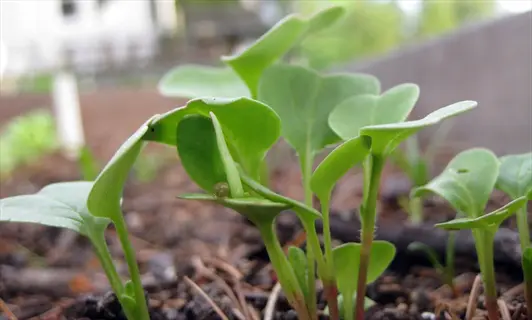
Radishes
- Growth Speed: Ready for harvest in just 3-6 weeks, the fastest-growing common garden vegetable suitable for multiple plantings per season.
- Space Needs: Thrives in just 3-4 inches of spacing between plants, ideal for small gardens or container growing with minimal area.
- Care Level: Requires only basic watering and thinning, making them perfect for beginners or low-maintenance gardening approaches.
- Yield Frequency: Can be harvested every 2-4 weeks through succession planting for continuous seasonal production.
- Soil Depth: Grows well in shallow 6-8 inch soil depths, adaptable to various container sizes and garden conditions.
- Climate Tolerance: Cold-hardy and can withstand light frosts, extending the growing season in both spring and fall.
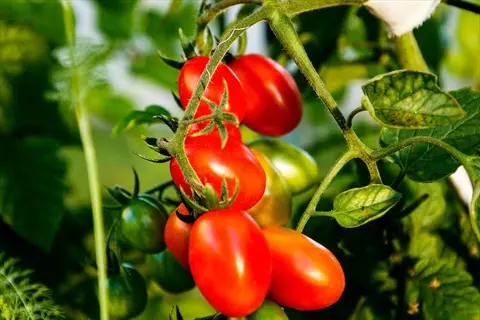
Tomatoes
- Growth Speed: Requires 60-100 days from planting to harvest, needing a long warm season for proper fruit development.
- Space Needs: Needs 18-36 inches between plants plus staking or caging support structures for optimal growth and air circulation.
- Care Level: Demands regular pruning, pest monitoring, and consistent watering to prevent blossom end rot and other issues.
- Yield Frequency: Single harvest period per plant though some varieties produce throughout summer until first frost.
- Soil Depth: Requires deep 12-18 inch soil for extensive root systems to support fruit production and plant health.
- Climate Tolerance: Heat-loving plants that struggle below 50°F (10°C) and require full sun exposure for optimal growth.
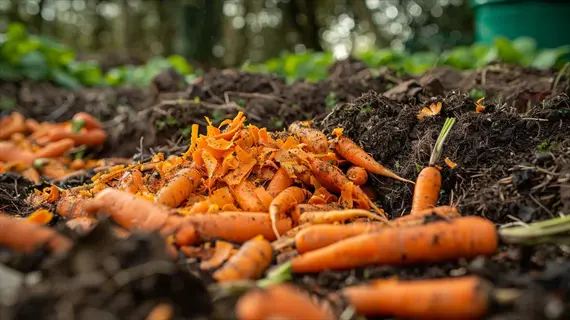
Carrots
- Growth Speed: Takes 70-80 days to mature, with slow germination requiring patience and careful moisture management initially.
- Space Needs: Requires 2-3 inches between plants but deep loose soil to prevent forked or stunted root development issues.
- Care Level: Needs consistent moisture and weed control during long growing period plus specific soil preparation requirements.
- Yield Frequency: Single harvest per planting though succession planting extends availability through the growing season.
- Soil Depth: Requires 12-inch loose, stone-free soil for straight root development without forking or deformation problems.
- Climate Tolerance: Prefers cooler temperatures around 60-70°F (15-21°C) and can handle light frost but not extreme heat.
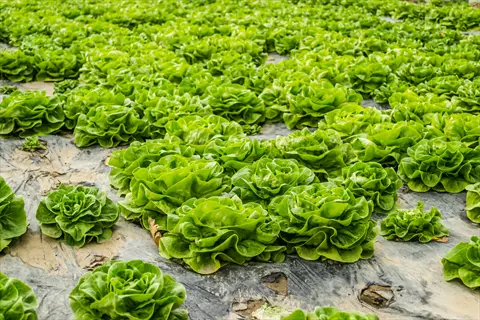
Lettuce
- Growth Speed: Leaf varieties ready in 30-45 days while heading types need 55-80 days depending on variety and conditions.
- Space Needs: Requires 6-12 inches between plants depending on variety with regular harvesting to encourage continuous growth.
- Care Level: Needs frequent watering and shade protection in heat to prevent bolting and bitter flavor development issues.
- Yield Frequency: Cut-and-come-again varieties provide multiple harvests while head varieties offer single harvest per plant.
- Soil Depth: Grows well in shallow 6-8 inch soil but benefits from consistent moisture and nutrient-rich growing conditions.
- Climate Tolerance: Cool-season crop that bolts quickly in temperatures above 75°F (24°C) requiring shade in summer months.
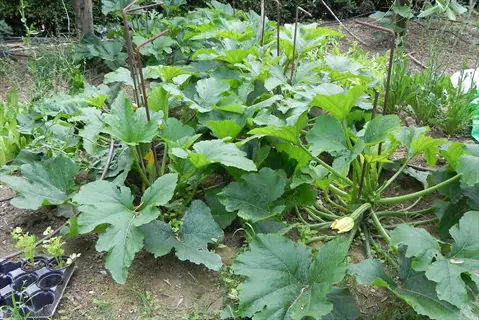
Zucchini
- Growth Speed: Produces harvestable squash in 45-55 days with vigorous vine growth requiring significant garden space allocation.
- Space Needs: Requires 24-36 inches between plants plus room for sprawling vines that can cover several square feet.
- Care Level: Needs regular pest monitoring for squash bugs/vine borers plus consistent watering for proper fruit development.
- Yield Frequency: High-yielding plants produce multiple fruits weekly during peak season once established and productive.
- Soil Depth: Benefits from 12-inch soil depth for root development but can tolerate shallower conditions when amended properly.
- Climate Tolerance: Warm-season crop that requires temperatures above 60°F (16°C) and full sun exposure for growth.
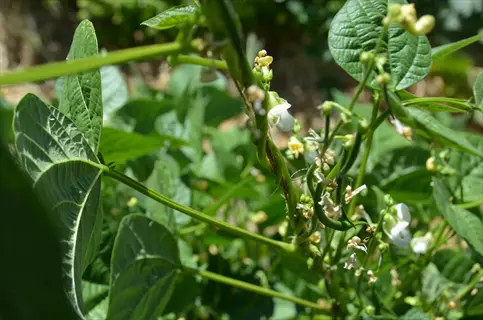
Green Beans
- Growth Speed: Bush varieties ready in 50-55 days while pole beans need 60-70 days to begin producing harvestable beans.
- Space Needs: Bush types need 4-6 inches while pole varieties require 6-8 inches plus vertical support structures for growth.
- Care Level: Relatively low maintenance but needs regular harvesting to encourage continued pod production throughout season.
- Yield Frequency: Continuous production for several weeks with multiple harvests possible from each planting when maintained.
- Soil Depth: Adaptable to various depths but prefers 8-10 inch well-draining soil for healthy root system development.
- Climate Tolerance: Warm-season crop that requires soil temperatures above 60°F (16°C) and cannot tolerate frost exposure.
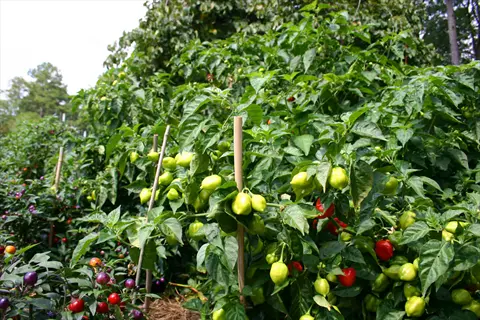
Peppers
- Growth Speed: Requires 60-90 days to mature fruits after transplanting, needing a long warm growing season for development.
- Space Needs: Needs 18-24 inches between plants with some varieties requiring staking support for heavy fruit loads.
- Care Level: Demands consistent warmth, full sun, and careful watering to prevent blossom drop and ensure proper fruiting.
- Yield Frequency: Continuous production once established with multiple harvests possible throughout the warm season period.
- Soil Depth: Requires 12-18 inch soil depth for substantial root systems to support plant growth and fruit production.
- Climate Tolerance: Extremely heat-loving plants that struggle below 55°F (13°C) and need warm nights for optimal development.
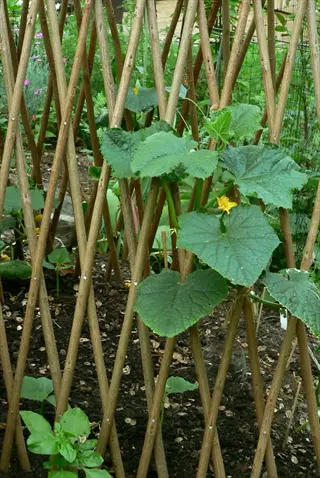
Cucumbers
- Growth Speed: Ready for harvest in 50-70 days depending on variety with vigorous vine growth requiring substantial space.
- Space Needs: Requires 12-24 inches between plants plus vertical trellising or room for sprawling vines across garden beds.
- Care Level: Needs consistent moisture to prevent bitter fruits and regular monitoring for common pests like cucumber beetles.
- Yield Frequency: High-yielding plants produce multiple fruits weekly during peak season when properly maintained and healthy.
- Soil Depth: Benefits from 12-inch soil depth but can tolerate shallower conditions when provided with consistent moisture.
- Climate Tolerance: Warm-season crop that requires temperatures above 70°F (21°C) and cannot tolerate any frost exposure.
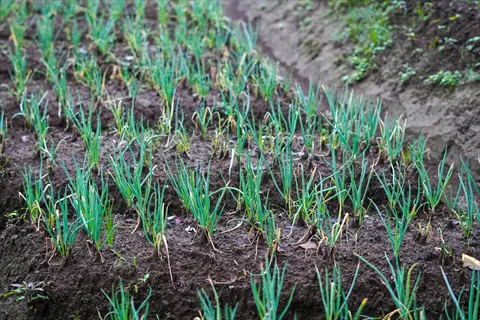
Onions
- Growth Speed: Requires 100-175 days from planting to harvest, needing a long growing season for proper bulb development.
- Space Needs: Needs 4-6 inches between plants with consistent weeding to prevent competition during slow growth phase.
- Care Level: Requires careful timing and specific day-length conditions for bulbing plus consistent moisture management throughout.
- Yield Frequency: Single harvest per planting though green onions can be harvested earlier in the growth cycle process.
- Soil Depth: Prefers well-drained soil at 6-inch depth but can develop in shallower conditions with proper amendments.
- Climate Tolerance: Cool-season crop that bulbs based on day length with specific variety requirements for different regions.
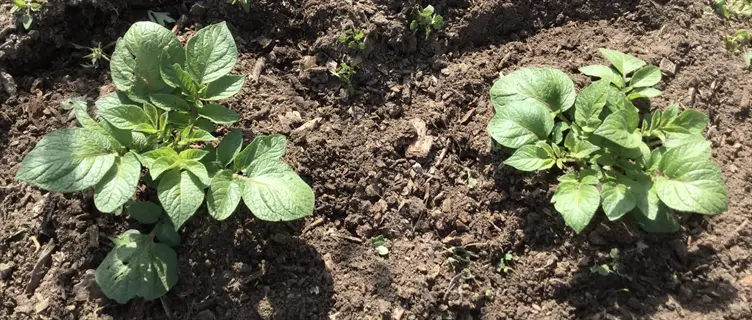
Potatoes
- Growth Speed: Requires 70-120 days depending on variety with hilling needed multiple times during the growing season.
- Space Needs: Needs 12-15 inches between plants with significant soil volume for tuber development and expansion underground.
- Care Level: Demands consistent hilling, pest monitoring for potato beetles, and careful harvesting to avoid tuber damage.
- Yield Frequency: Single harvest per planting though new potatoes can be harvested earlier in the growth cycle.
- Soil Depth: Requires deep loose soil (at least 12 inches) for proper tuber formation without deformities or restrictions.
- Climate Tolerance: Cool-season crop that prefers temperatures around 60-70°F (15-21°C) and can handle light frost exposure.
Choosing Radish Varieties
Knowing radish types helps with selection. Garden radishes, such as Cherry Belle, have a quick maturity of three weeks. Winter radishes, such as Daikon, take two months to mature but can be stored. Choose based on your timing and gardening goals.
A French breakfast is an ideal start. They are consistent growers in many kinds of soils. The long shape makes them easy to pull out of the ground. New gardeners are successful with these every year because they have a mild flavor and mature quickly.
Radishes are surprising in their variety of colors. The "Easter Egg" radish mixed varieties will produce roots in pink, purple, and white colors. Watermelon radishes have green skins and bright pink flesh inside. What a delight they are on a salad! Colorful harvests are always the thing that makes kids the happiest!
Plant varieties based on seasonal periods. In the spring season, fast-growing garden varieties such as French Breakfast radishes are suitable. In the fall and winter, varieties such as Black Spanish radishes are most suitable. Plant the appropriate varieties based on temperature to get the best flavor and texture.
How to Plant Radish Seeds
For fast sprouting, sow radish seeds when the soil temperature is between 50°F and 65°F. Use a soil thermometer to ensure your conditions are right. Soil that is too cool causes slow germination, and hot soil generates inadequate leaf growth. This temperature sweet spot yields seedlings in 4 to 7 days.
Create shallow furrows appropriate for your chosen radish type. Create furrows 0.5 inch deep if you are growing small kinds of radishes, such as Cherry Belle. Medium types, such as French Breakfast, will germinate well if planted at a furrow depth of 0.75 inches. Ideally, space the rows 10-15 cm apart to allow them to develop their roots.
Sow seeds directly in the garden beds, always. The process of transplanting seedlings can disrupt delicate roots, potentially leading to stunted and unruly growth. Additionally, if the soil crusts after watering, lightly mist the soil surface to prevent it from becoming too dry. This loosens the surface for better sprout emergence.
Different sizes require specific spacing. Place small radish seeds 2-3 inches apart. Allow 4-6 inches of space between large varieties, such as Daikon. Proper spacing prevents crowding and ensures plump roots.
Soil Preparation
- Loosen soil to 6-12 inch depth using garden fork or tiller
- Remove rocks and debris to prevent deformed roots
- Mix in 1-2 inch layer of compost for drainage and nutrients
- Avoid nitrogen-rich fertilizers that promote leafy growth over roots
Sowing Technique
- Create straight furrows 10-15cm apart using hoe or stick
- Plant seeds 0.5-1 inch deep (shallower for small varieties)
- Space seeds 3-5cm apart in furrows for proper root development
- Cover lightly with soil and gently firm surface with hands
Initial Watering
- Water gently with watering can rose to avoid displacing seeds
- Maintain consistently moist soil until germination (5-10 days)
- Provide 0.25 inch water daily if no rainfall occurs
- Use crusted soil hack: Mist hardened surface to soften
Temperature Management
- Ideal soil temperature: 50-65°F (10-18°C) for germination
- Use fleece protection if temperatures drop below 35°F (2°C)
- In hot weather (>70°F/21°C), plant in partial shade areas
- Monitor with soil thermometer for optimal conditions
Special Scenarios
- Container planting: Use pots minimum 6 inches deep with drainage
- Marker seeds: Plant with slow-germinators like carrots as indicators
- Succession planting: Sow new rows every 2-4 weeks
- Avoid transplanting: Causes root damage and deformities
Caring for Radishes
Water radishes with care at all growth stages. During the germination stage, provide 0.25 inches of daily water to maintain soil moisture. Once grown, provide 1 inch of water weekly through deep watering. If it is hot, increase the water to 1.5 inches to prevent the root from splitting.
Thin seedlings when they are 2 inches tall with 2 true leaves. Use scissors to cut away the excess soil. Garden radishes should be 2-4 inches apart. This allows roots to grow without overcrowding.
Before planting, incorporate organic sources of nutrition into the soil, such as compost. If growth levels slow or appear stagnant, fertilize with a seaweed emulsion every two weeks to help your plants. Avoid using high-nitrogen fertilizer - although leaf growth will be great, the roots will not develop properly. For containers, dilute the liquid fertilizer to half-strength.
Control pests using basic techniques. Use row covers to protect young plants from flea beetles. Sprinkle diatomaceous earth around the stems to deter root maggots. Use crop rotation to prevent soil diseases from building up each season.
Watering Schedule
- Germination phase: 0.25 inch daily to keep soil moist
- Growth phase: 1 inch weekly, deeply soaking soil
- Hot weather: Increase to 1.5 inches weekly to prevent cracking
- Container plants: Check daily, water when top inch is dry
Thinning Process
- Timing: When seedlings reach 2 inches tall with 2 true leaves
- Method: Snip extras at soil level using scissors
- Spacing: Maintain 2-4 inches for garden radishes
- Transplant option: Gently move excess seedlings if roots intact
Fertilization
- Pre-planting: Mix compost into soil (no fresh manure)
- Mid-growth: Seaweed emulsion every 2 weeks if needed
- Avoid: High-nitrogen fertilizers that promote leaves over roots
- Container option: Balanced liquid fertilizer at half strength
Weed Control
- Mulching: Apply 2-inch straw layer to suppress weeds
- Shallow cultivation: Use hoe carefully to avoid root damage
- Hand-pulling: Remove weeds near seedlings manually
- Timing: Weed weekly during early growth stages
Disease Prevention
- Crop rotation: Avoid planting in same spot more than once per year
- Air circulation: Ensure proper spacing between plants
- Water management: Water at base to keep foliage dry
- Resistant varieties: Choose disease-tolerant types like Cherry Belle
When to Plant Radishes
In the spring, plant radishes 2-4 weeks before your last frost date, allowing the seeds to germinate in cool soil at around 50°F. Given this, in my experience, mid-April plantings are ideal for gardeners in Zones 5-6. If you live in coastal areas, you could start in March.
For autumn harvests, count back 6-8 weeks from your first expected frost. Late August works well for many areas. Winter varieties (such as Daikon above) are sweeter when planted in cooler fall soil, making ideal roots for winter storage.
USDA zones dictate specific planting windows. Those who garden in USDA zones 3-4 will plant in May. Those who are in USDA zones 9-10 can grow year-round. To determine your USDA zone, refer to the USDA Plant Hardiness Zone Map. Your local coastal microclimates can often result in extended planting seasons.
Avoid planting in the summer when daytime temperatures consistently reach 70° or higher. The heat causes flowering to occur prematurely, one of the primary factors responsible for producing woody roots. I've seen many crops fail due to planting in July. The situation is different for coastal gardens, as they remain cool in the summer.
Spring Planting
- Begin 2-4 weeks before last expected frost when soil reaches 50°F (10°C)
- Ideal window: March-April in temperate zones for quick harvest before summer heat
- Use fleece protection if late frost occurs after planting
- Best varieties: French Breakfast, Cherry Belle (bolt-resistant types)
Fall Planting
- Start 6-8 weeks before first expected frost for slower, sweeter roots
- Optimal timing: August-September in most regions for October-November harvest
- Cooler temperatures enhance flavor development in winter varieties
- Recommended types: Daikon, Watermelon radish (cold-tolerant)
Winter Planting
- In zones 9-11: Plant October-January for continuous winter harvest
- Use cold frames or cloches in cooler zones for frost protection
- Soil should remain above 40°F (4°C) for successful germination
- Suitable varieties: All-season types like White Icicle
Summer Considerations
- Avoid planting when temperatures exceed 70°F (21°C) consistently
- If planting in summer, choose partial shade locations
- High heat causes bolting (flowering) and woody, bitter roots
- Exception: Cool coastal climates with moderate summer temperatures
Succession Planting
- Sow new batches every 2-4 weeks from early spring to late fall
- Extends harvest window and ensures continuous supply
- Rotate planting locations to prevent soil-borne diseases
- Track planting dates using garden journal or calendar
5 Common Myths
Radishes need full sun at all times to develop properly.
While radishes benefit from 6 hours of daily sunlight, they actually thrive in partial shade during summer months when temperatures exceed 70F. French Breakfast and Cherry Belle varieties produce excellent roots with just 4-5 hours of morning sun followed by afternoon shade, which prevents bolting and maintains crisp texture without sacrificing growth rate.
Radish varieties can be grown every season in every climate.
All radish varieties have seasonal preferences: garden radish varieties, including French Breakfast, generally grow well in cool spring or fall, but winter radishes, such as daikon, have their own temperature requirements that need to be accommodated. If we try growing garden radish varieties in the summer, they tend to bolt, and the winter varieties usually die from hard frosts if we do not protect them. Successful radish growers used to varieties ultimately do better with growing radishes locally and according to the seasons.
Transplanting radish seedlings is an efficient way to control spacing.
However, radish roots become easily damaged when transplanting which can affect the shape and growth of the plant. Thus, direct sowing becomes important because once the taproots become established, they will not respond well to disturbance. To get the best results, ideally, seeds should always be planted in their final growing position. If you need to thin seedlings, do so carefully and snip unwanted seedlings at soil level as pulling seedlings can damage the roots of seedlings you want to leave.
Bigger radishes will generally have better flavor and quality.
When radishes become very large they develop a woody, pithy texture and should not taste excessively spicy, although some variation is expected with different varieties. Roots should be harvested at about 1-inch diameter for the types typically grown in gardens (like Cherry Belle) and at about the size of a tennis ball for winter radishes like Watermelon. Harvesting radishes before they become too large will help ensure they do not become unpalatable (too woody, pithy, or spicy) and will help them develop crispy texture and proper flavor balance.
Radish greens can be tossed after harvest, as they are inedible.
Radish greens are extremely nutritious and have more vitamin C, calcium, and iron than the roots. Use them raw, in salads, for a peppery punch, or cook them with soute, like spinach, or use them in a pesto. The young ones harvested while thinning them are good microgreens. Always wash well and consume within 2-3 days for best flavor and texture.
Conclusion
Radishes are the ideal first crop for beginning gardeners. They require no special equipment and only small spaces. With very low care requirements, success is virtually assured. You get edible roots faster than any vegetable. It will not take long to build new gardener confidence.
There is nothing like the absolute excitement of harvesting food weeks after planting it. It is radishes that fulfill this gratification. You can see the seeds turn into crunchy roots before any other vegetables germinate. This fast turnaround is why radishes make gardening fun and fulfilling season after season.
Plant different varieties in different seasons. You can plant Cherry Belle in the spring. Daikon can be planted in the fall. Try using colorful Easter Egg radishes as well. Each has its own specific flavor and texture. A big part of the fun is determining which you like best. The fact that variety increases your skill as a gardener.
Get your hands on some seeds and plant them today! Look for a nice, sunny area in your garden or on your patio. Follow the simple steps below. You will be enjoying fresh radishes before summer. Get started growing now for the fastest harvest ever.
External Sources
Frequently Asked Questions
What should not be planted near radishes?
Avoid planting radishes near hyssop or potatoes, as they inhibit growth. Instead, pair radishes with beneficial companions:
- Cucumbers: Radishes deter cucumber beetles
- Lettuce: Provides shade for heat-sensitive radishes
- Carrots: Marks rows while roots develop at different depths
Can radishes grow year-round?
Radishes have seasonal preferences depending on variety. Garden radishes thrive in cool spring/fall temperatures, while winter types like Daikon grow best in cold months. In USDA zones 9-11 with mild winters, year-round cultivation is possible with proper variety selection.
How do you plant French Breakfast radishes?
Plant these cylindrical radishes in early spring or fall by:
- Sowing seeds 0.75 inches deep in loose soil
- Spacing plants 3-4 inches apart in rows
- Providing consistent moisture without waterlogging
- Harvesting in 28 days when roots reach 1-inch diameter
How long until radish seeds sprout?
Germination typically occurs within 4-10 days under optimal conditions. Speed varies significantly by variety and temperature:
- Cherry Belle: 4-6 days at 50-65°F soil temperature
- Daikon: 7-10 days in cooler fall conditions
- Delayed sprouting occurs below 40°F or above 75°F
Do radishes deter garden pests?
Yes, radishes act as natural pest repellents through companion planting. They deter cucumber beetles near squash vines and repel aphids from lettuce. Their pungent odor also confuses root maggots seeking carrot crops when planted in alternating rows.
Are radishes beginner-friendly?
Radishes are perfect for beginners due to their rapid growth and minimal requirements. They tolerate various soil types, need only basic watering and thinning, and show visible results in 3-6 weeks, making them ideal confidence-building starter crops.
What makes radishes grow fastest?
Optimal conditions accelerate radish growth:
- Soil temperature: 50-65°F (10-18°C)
- Loose, rock-free soil at 6-12 inch depth
- Consistent moisture: 1 inch water weekly
- Full sun exposure with afternoon shade in heat
Should radishes be started indoors?
Direct sowing is strongly recommended over indoor starts. Radish roots suffer transplant shock easily, leading to deformed growth. Always plant seeds directly in garden beds or containers where they'll mature, thinning seedlings instead of moving them.
How many radishes grow from one plant?
Each radish seed produces a single edible root. For continuous harvests, practice succession planting: sow new seeds every 2-4 weeks during growing seasons. This ensures a steady supply rather than multiple harvests from individual plants.
Are radishes beneficial for health?
Radishes offer significant health benefits:
- Roots provide vitamin C, potassium and digestive fiber
- Greens contain more nutrients than roots - rich in calcium and iron
- Compounds support liver detoxification and healthy digestion
- Low calorie density makes them ideal for weight management
